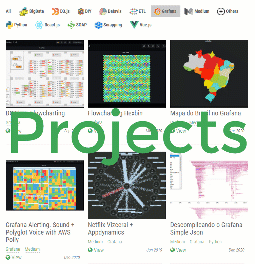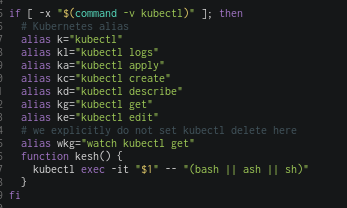- https://www.udemy.com/course/learn-kubernetes/
- https://www.udemy.com/course/certified-kubernetes-administrator-with-practice-tests/
- Certified Kubernetes Administrator:
- https://www.cncf.io/certification/cka/
- Exam Curriculum (Topics):
- https://github.com/cncf/curriculum
- Candidate Handbook:
- https://www.cncf.io/certification/candidate-handbook
- Exam Tips:
- http://training.linuxfoundation.org/go//Important-Tips-CKA-CKAD
- Certified Kubernetes Administrator:
- Useful:
- https://medium.com/dev-genius/kubernetes-for-local-development-a6ac19f1d1b2
- docker desktop
- minikube
- kind
- k3s
- https://computingforgeeks.com/kubectl-cheat-sheet-for-kubernetes-cka-exam-prep/
- start a temporary pod that dies on exit
kubectl run --rm -it --image=<image> <podname> -- sh
- create namespace
kubectl create namespace <name>kubectl create ns <name>
- starting session to the pod
kubectl exec --stdin --ty ubuntu -- shkubectl exec --stdin --ty ubuntu -- /bin/bashkubectl exec --stdin --ty ubuntu -- ls -lt /etc/hosts
- run pod
kubectl run nginx --image=nginx --restart=Never --dry-run=client -o yamlkubectl run nginx --image=nginx --restart=Never --limits='cpu=300m,memory=512Mi' --dry-run=client -o yamlkubectl run nginx --image=nginx --restart=Never --requests='cpu=100m,memory=256Mi' --limits='cpu=300m,memory=512Mi' --dry-run=client -o yamlkubectl run nginx --image=nginx --restart=Never --dry-run=client -o yaml >nginx-pod.yaml
- start a temporary pod that dies on exit
- https://medium.com/dev-genius/kubernetes-for-local-development-a6ac19f1d1b2

Kubernetes for the Absolute Beginners - Hands-on
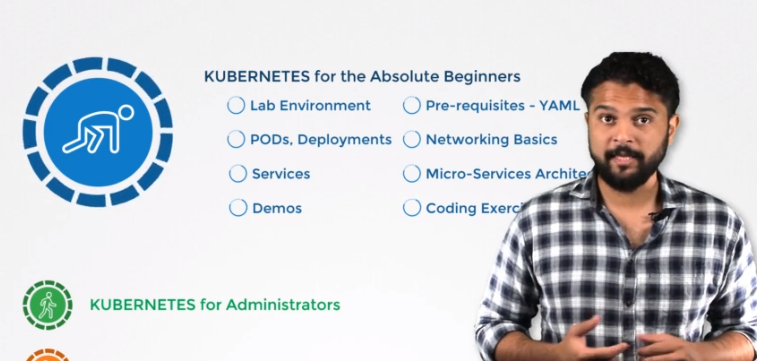
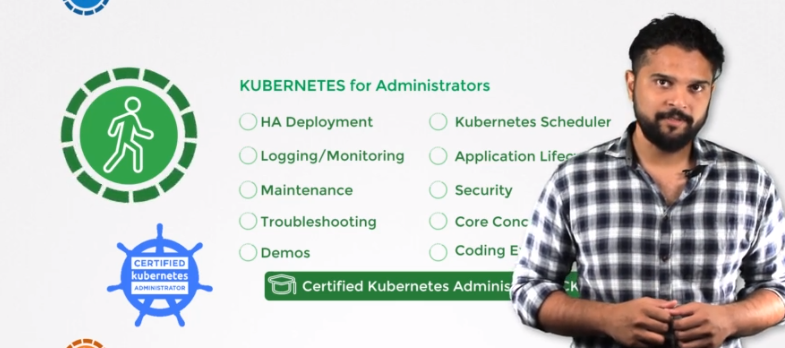



Certified Kubernetes Administrator (CKA) with Practice Tests

- Master
- ETCD Cluster
- kube-apiserver
- Kube Controller Manager
- Node Controller
- Node Monitor Period = 5s
- Node Monitor Grace Period = 40s
- POD Eviction Timeout = 5m
- Replication Controller
- Node Controller
- kube-scheduler
- Decides which pod goes on which node.
- Worker
- kubelet
- kube-proxy
- Container runtime:
- rkt
- docker
- cri-o
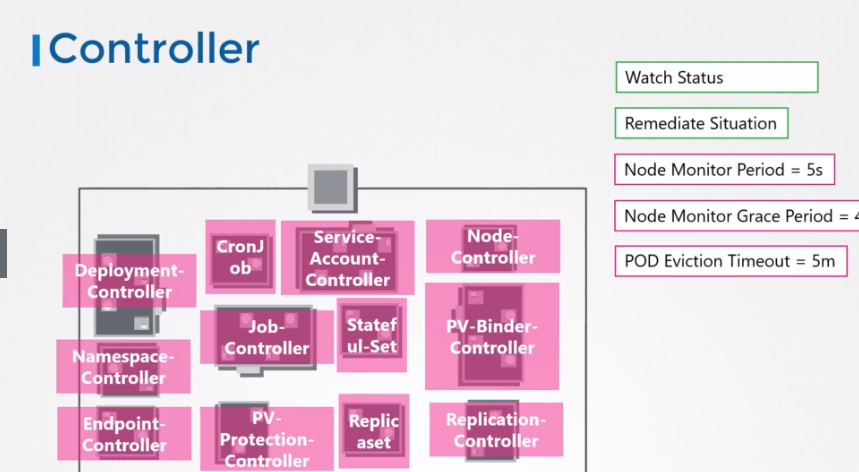
Kube scheduler
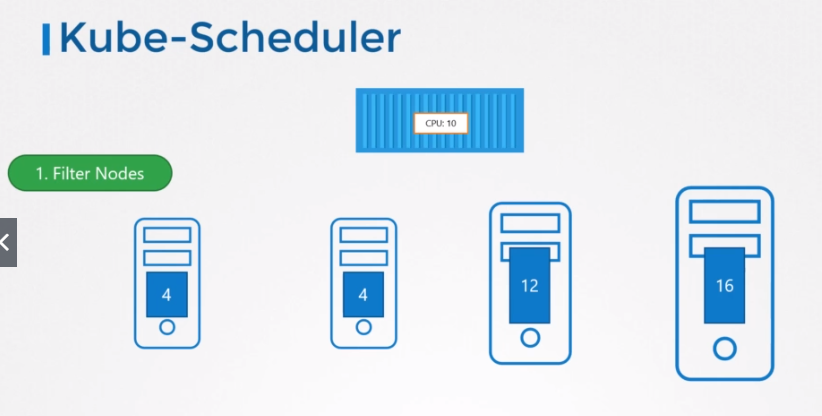

calculates the amount of resources that will be free after the pod is allocated

Storage
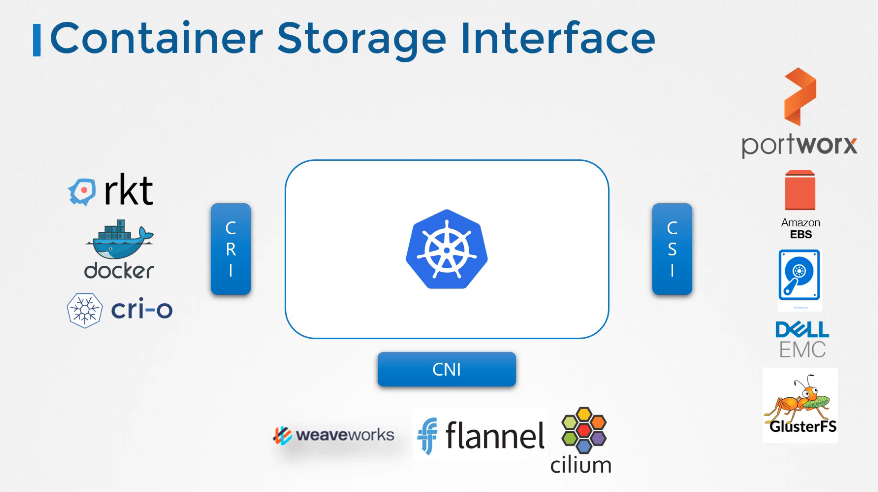
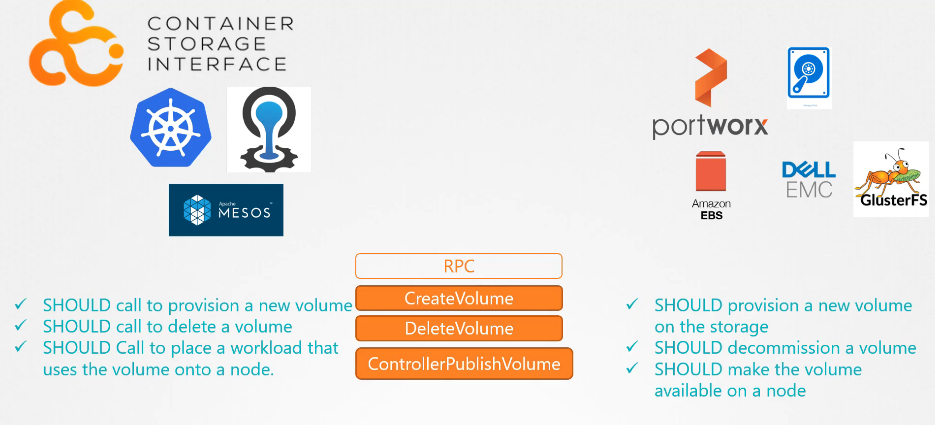
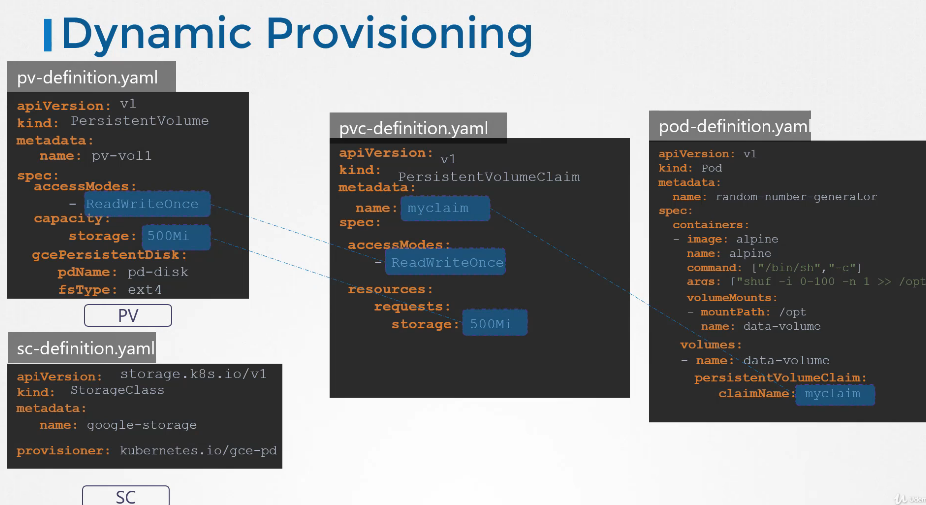
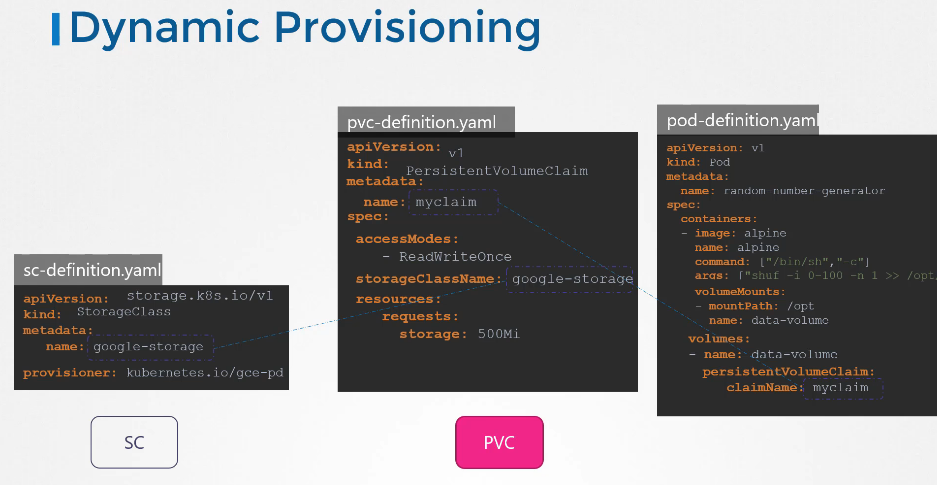
TLS
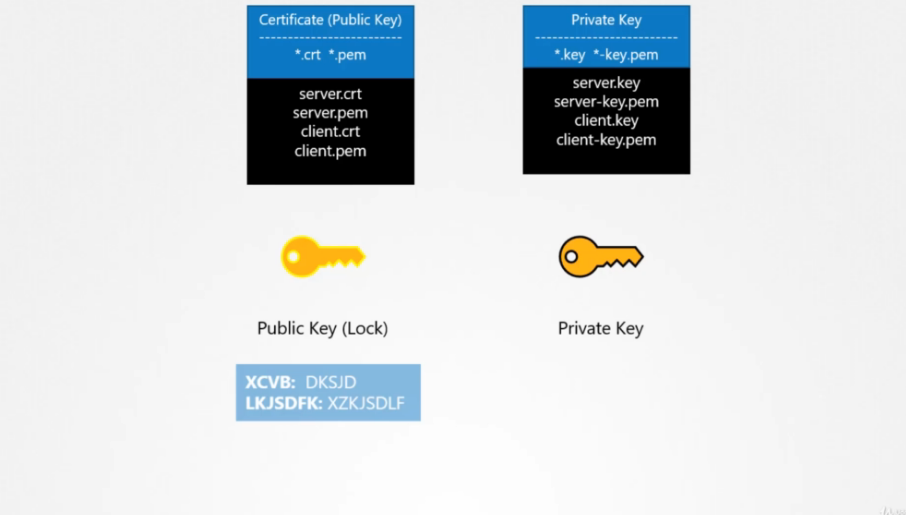
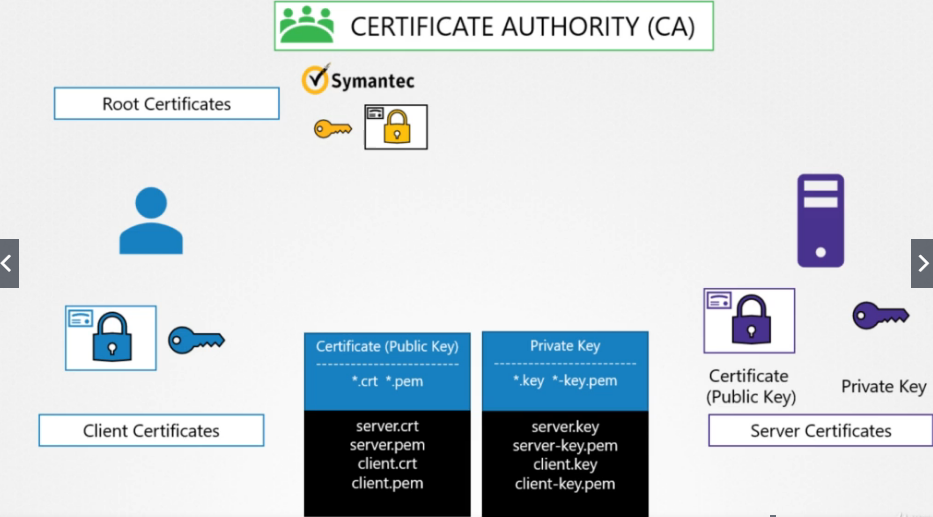
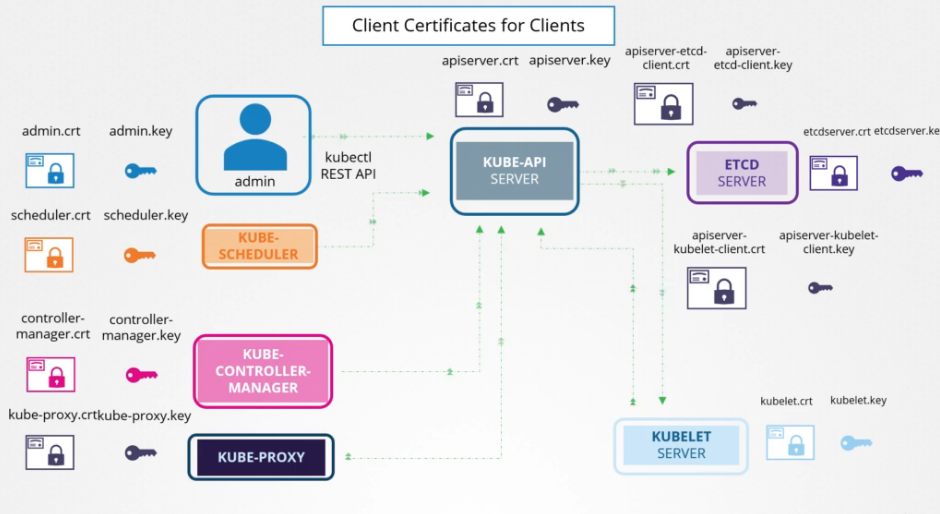
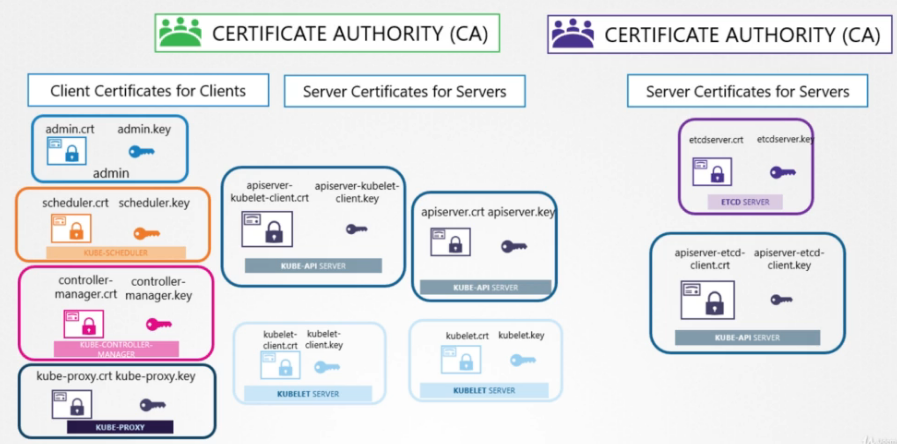


Design a Kubernetes Cluster
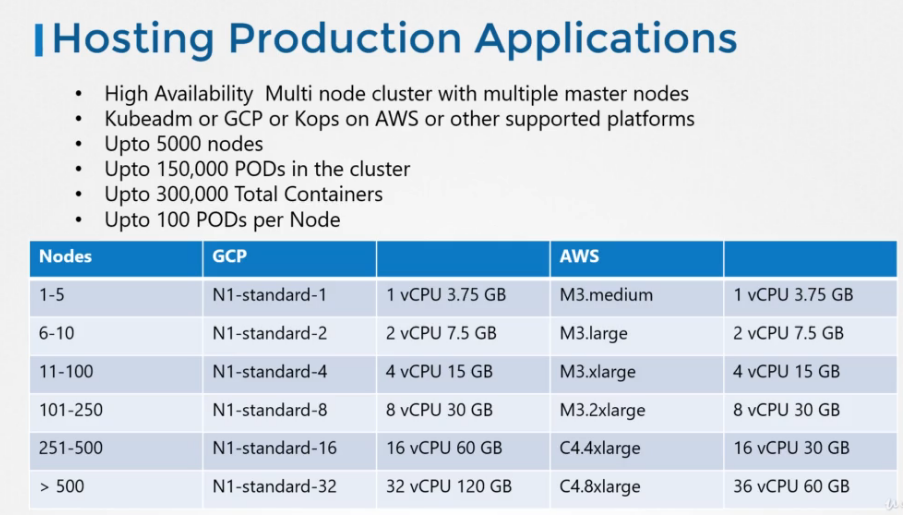
Cheat Sheet
Create Nginx Pod
kubectl run nginx --image=nginx
Generate POD Manifest YAML file (-o yaml). Don’t create it (–dry-run)
kubectl run nginx --image=nginx --dry-run=client -o yaml
Generate Deployment YAML file (-o yaml). Don’t create it(–dry-run) with 4 Replicas (–replicas=4)
kubectl create deployment --image=nginx nginx --dry-run=client -o yaml > nginx-deployment.yaml
kubectl get pods --namespace=devkubectl get podskubectl config set-context $(kubectl config current-context) --namespace=dev-
kubectl get pods --all-namespaces - General
- Enroll for exam
- https://training.linuxfoundation.org/certification/certified-kubernetes-administrator-cka/
- Enroll for exam
- Articles
- https://www.contino.io/insights/the-ultimate-guide-to-passing-the-cka-exam
- Books
- Kubernetes in Action by Marko Luksa
- Kubernetes Up and Running by Kelsey Hightower, Brendan Burns, Joe Beda
- DevOps with Kubernetes by Hideto Saito, Hui-Chuan Chloe Lee, Cheng-Yang Wu
- The Kubernetes Book by Nigel Poulton
- Tools
- tmux, vi, systemd, kubectl, cfssl/openssl
- Alias
-
alias kc='kubectl' alias kgp='kubectl get pods' alias kgs='kubectl get svc' alias kgc='kubectl get componentstatuses’ alias kctx='kubectl config current-context’ alias kcon='kubectl config use-context’ alias kgc='kubectl config get-context'
-
- Books
- https://www.axelerant.com/resources/team-blog/how-become-certified-kubernetes-administrator
- Aliases:
alias k='kubectl'alias kg='kubectl get'
- Aliases:
- https://www.reddit.com/r/kubernetes/comments/ndwgkr/the_story_of_3_attempts_at_cka_and_how_killersh/
- https://brownfield.dev/post/2021-05-13-series-cert-cka/
- 2 browser tabs, one for the exam and one for https://kubernetes.io/docs
- Get good with vim
- Use the docs for references
- Learn how to confirm since the test won’t help you
kubectl,etcdtl,systemctlare the important commands
- Killer.sh CKA Simulator
- https://killer.sh/cka
- 2 browser tabs, one for the exam and one for https://kubernetes.io/docs
- https://brownfield.dev/post/2021-05-13-series-cert-cka/
- My views on CKA
- https://www.reddit.com/r/kubernetes/comments/nejmo5/my_views_on_cka/
- https://apaarshrm39.medium.com/k8s-speed-run-how-i-aced-ck-ad-s-in-35-days-with-a-day-occasionally-night-job-fbf60d2ebe0c
-
alias k="kubectl" alias kn="kubectl config set-context --current --namespace" export y="--dry-run=client -o yaml" - Make sure you are aware of these directories: I came across an article which summarized all the important directories in a single place, give it a look: https://brandonwillmott.com/2020/10/01/important-directories-to-know-for-kubernetes-cka-exam/
- Practice and Understand ETCD backup thoroughly: I see people lost in this topic the most, practice it again and again, the backup as well as restore, don’t forget to mount the location of the restored backup on the etcd static pod. Refer this link: https://github.com/mmumshad/kubernetes-cka-practice-test-solution-etcd-backup-and-restore
-
- https://www.reddit.com/r/kubernetes/comments/nrs1ry/today_i_got_my_cka_here_are_some_tips/
- https://medium.com/swlh/my-take-towards-cka-ckad-september-curriculum-update-tips-ff38e7585447
- Cluster Maintenance(11%) + Installation, Configuration & Validation(12%) = Cluster Architecture, Installation & Configuration(25%)
- Manage role-based access control (RBAC) Using RBAC Authorization
- Use Kubeadm to install a basic cluster create cluster using kubeadm
- Manage a highly-available Kubernetes cluster highly available cluster
- Provision underlying infrastructure to deploy a Kubernetes cluster
- Perform a version upgrade on a Kubernetes cluster using Kubeadm Upgrading kubeadm clusters
- Implement etcd backup and restore ETCD backup and restore
- Networking(11%) + Core Concepts(19%) = Services & Networking(20%)
- Understand host networking configuration on the cluster nodes Nodes, Node communication
- Understand connectivity between Pods Pod to Pod Communication
- Understand ClusterIP, NodePort, LoadBalancer service types and endpoints Services
- Know how to use Ingress controllers and Ingress resources Ingress controller, Ingress resource
- Know how to configure and use CoreDNS CoreDNS
- Choose an appropriate container network interface plugin network plugins
- Logging/Monitoring(5%) + Troubleshooting 10% = Troubleshooting(30%)
- Troubleshoot application failure: Troubleshooting application, debug Pod failure, debug Init containers
- Troubleshoot cluster component failure: Troubleshoot clusters, troubleshoot kubeadm
- Troubleshoot networking: debug DNS resolution, debug service
- Scheduling(5%) + Application Lifecycle Management(8%) = Workloads & Scheduling(15%)
- Understand deployments and how to perform rolling update and rollbacks Perform a Rollback on a DaemonSet
- Use ConfigMaps and Secrets to configure applications Configure a Pod to Use a ConfigMap, Distribute Credentials Securely Using Secrets
- Know how to scale applications Scaling your application, Scale a StatefulSet
- Understand the primitives used to create robust, self-healing Deploy an App
- Understand how resource limits can affect Pod scheduling Assign CPU Resources to Containers and Pods, Assign Memory Resources to Containers and Pods
- Awareness of manifest management and common templating tools
- Storage(7%) = Storage(10%)
- Understand storage classes, persistent volumes Storage Classes, Persistent Volumes, Persistent Volume Claims
- Understand volume mode, access modes and reclaim policies for volumes Volume Modes, Access Modes, Update Reclaim Policy
- Understand persistent volume claims primitive
- Know how to configure applications with persistent storage Storage, Persistent Volumes
- Cluster Maintenance(11%) + Installation, Configuration & Validation(12%) = Cluster Architecture, Installation & Configuration(25%)
- https://www.contino.io/insights/the-ultimate-guide-to-passing-the-cka-exam
- Useful
- https://github.com/cloudogu/k8s-diagrams?utm_sq=ggoh6xujj8
- Learn
- https://play.instruqt.com/public
- Book
- Kubernetes: Preparing for the CKA and CKAD Certifications
- Curriculum CKA 1.19: Sep 2020
- Cluster Architecture, Installation, and Configuration (25%)
- Manage role-based access control (RBAC) - Authorization Chapter 11
- Use kubeadm to install a basic cluster - Chapter 1
- Manage a highly available Kubernetes cluster - Chapter 1
- Provision underlying infrastructure to deploy a Kubernetes cluster - Chapter 1
- Perform a version upgrade on a Kubernetes cluster using kubeadm - Chapter 15
- Implement etcd backup and restore - “Back Up a Cluster”, “Restore a Cluster” Chapter 15
- Workloads and Scheduling (15%)
- Understand deployments and how to perform rolling update and rollbacks - “ReplicaSet Controller”, “Deployment Controller”, “Update and Rollback”, and “Deployment Strategies”, Chapter 5
- Use ConfigMaps and Secrets to configure applications - Chapter 6
- Know how to scale applications - Chapter 7
- Understand the primitives used to create robust, self-healing, application deployments - Chapter 8
- Understand how to resource limits can affect Pod scheduling - “Resource Requests” Chapter 9
- Awareness of manifest management and common templating tools - “Helm”, “Kustomize”, Chapter 16
- Services and Networking (20%)
- Understand host networking configuration on the cluster nodes - Chapter 1
- Understand connectivity between Pods - Chapter 1
- Understand ClusterIP, NodePort, and LoadBalancer service types and endpoints - Chapter 10
- Know how to use Ingress controllers and Ingress resources - Chapter 10
- Know how to configure and use CoreDNS - Chapter 1
- Choose an appropriate container network interface plugin - Chapter 1
- Storage (10%)
- Understand storage classes and persistent volumes - Chapter 12
- Understand mode, access modes, and reclaim policies for volumes - “Access Modes”, “Claiming a Persistent Volume” Chapter 12
- Understand persistent volume claims primitive - “Claiming a Persistent Volume” Chapter 12
- Know how to configure applications with persistent storage - “Persistent Volume” Chapter 12
- Troubleshooting (30%)
- Evaluate cluster and node logging - Chapter 2
- Understand how to monitor applications - “Auto-scaling” Chapter 7; “kubectl” Chapter 16
- Manage container stdout and stderr logs - Logging in the Chapter 14
- Troubleshoot application failure - Basic logging, “kubectl”, Chapter 16
- Troubleshoot cluster component failure - Chapter 2
- Troubleshoot networking - Chapter 2, Chapter 10, “kubectl”, Chapter 16
- Cluster Architecture, Installation, and Configuration (25%)
- Curriculum CKA 1.19: Sep 2020
- Kubernetes: Preparing for the CKA and CKAD Certifications
- Commands
- POD
kubectl run --restart=Never --image=busybox static-busybox --dry-run=client -o yaml --command -- sleep 1000 > /etc/kubernetes/manifests/static-busybox.yamlkubectl get pod --namespace=kube-systemkubectl run nginx --image=nginxkubectl run nginx --image=nginx --dry-run=client -o yamlkubectl run custom-nginx --image=nginx --port=8080kubectl run httpd --image=httpd:alpine --port=80 --exposekubectl -n elastic-stack exec -it app cat /log/app.log
- Deployment
kubectl create deployment --image=nginx nginxkubectl create deployment --image=nginx nginx --dry-run -o yamlkubectl create deployment nginx --image=nginx --replicas=4kubectl scale deployment nginx --replicas=4kubectl create deployment nginx --image=nginx--dry-run=client -o yaml > nginx-deployment.yamlkubectl edit deployment <name>
- ConfigMaps
kubectl create configmap<config-name> --from-literal=<key>=<value>
kubectl create configmap <config-name> --from-file=<path to file>
- Service
kubectl expose pod redis --port=6379 --name redis-service --dry-run=client -o yamlkubectl create service clusterip redis --tcp=6379:6379 --dry-run=client -o yamlkubectl expose pod nginx --port=80 --name nginx-service --type=NodePort --dry-run=client -o yamlkubectl create service nodeport nginx --tcp=80:80 --node-port=30080 --dry-run=client -o yaml
- Namespace
kubectl create namespace mysqlkubectl -n <namespace>kubectl config set-context --current --namespace default
- Taints
kubectl describe node kubemaster | grep Taintkubectl taint nodes node01 spray=mortein:NoSchedulekubectl taint nodes master/controlplane node-role.kubernetes.io/master:NoSchedule-
- Label Nodes
kubectl label nodes <node-name> <label-key>=<label-value>kubectl label nodes node-1 size=Large
- Events
kubectl get events
- Logs
kubectl logs <podname> --namespace=<namespace>kubectl logs -f <podname> <containername> --namespace=<namespace>
- Secrets
echo -n 'password' | base64echo -n 'password' | base64 --decodekubectl get secretskubectl describe secretskubectl get secret app-secret -o yamlkubectl get secret --namespace mysql mysql -o jsonpath="{.data.mysql-root-password}" | base64 --decodekubectl create secret generic app-secret --from-literal=DB_Host=mysqlkubectl create secret generic app-secret --from-file=<filepath>
- POD
- Imperative
- Create Objects
- kubectl run –image=nginx nginx
- kubectl create deployment –image=nginx nginx
- kubectl expose deployment nginx –port 80
- Update Objects
- kubectl edit deployment nginx
- kubectl scale deployment nginx –replicas=5
- kubectl set image deployment nginx nginx=nginx:1.18
- Deployments
kubectl edit deployment <my deployment>
- Create Objects
- YAML
- Resource Requirements
- https://kubernetes.io/docs/tasks/configure-pod-container/assign-memory-resource
- mem https://kubernetes.io/docs/tasks/administer-cluster/manage-resources/memory-default-namespace/
- ``` apiVersion: v1 kind: LimitRange metadata: name: mem-limit-range spec: limits:
- default: memory: 512Mi defaultRequest: memory: 256Mi type: Container ```
- ``` apiVersion: v1 kind: LimitRange metadata: name: mem-limit-range spec: limits:
- cpu https://kubernetes.io/docs/tasks/administer-cluster/manage-resources/cpu-default-namespace/
-
apiVersion: v1 kind: LimitRange metadata: name: cpu-limit-range spec: limits: - default: cpu: 1 defaultRequest: cpu: 0.5 type: Container
-
- mem https://kubernetes.io/docs/tasks/administer-cluster/manage-resources/memory-default-namespace/
- https://kubernetes.io/docs/tasks/configure-pod-container/assign-memory-resource
- Resource Requirements
- Useful
- https://kubernetes.io/docs/reference/kubectl/conventions/
- https://twitter.com/Sh1bumi/status/1388973503400103939
Install Kind
https://kubernetes.io/docs/tasks/tools/install-kubectl-linux/
Install kubectl
curl -LO "https://dl.k8s.io/release/$(curl -L -s https://dl.k8s.io/release/stable.txt)/bin/linux/amd64/kubectl"
chmod +x kubectl
mv kubectl /usr/bin/
https://kind.sigs.k8s.io/docs/user/quick-start/
wget https://dl.google.com/go/go1.13.linux-amd64.tar.gz
tar xzvf go1.13.linux-amd64.tar.gz -C /opt
cat <<EOF > ~/.bashrc
export PATH="/opt/go/bin/:$PATH"
export GOPATH="/opt/go/"
EOF
GO111MODULE="on" go get sigs.k8s.io/kind@v0.10.0
kind create cluster
kubectl cluster-info --context kind-kind
kubectl cluster-info --context kind-kind
Kubernetes control plane is running at https://127.0.0.1:46150
KubeDNS is running at https://127.0.0.1:46150/api/v1/namespaces/kube-system/services/kube-dns:dns/proxy
To further debug and diagnose cluster problems, use 'kubectl cluster-info dump'.
https://kind.sigs.k8s.io/docs/user/quick-start/#advanced
# this config file contains all config fields with comments
# NOTE: this is not a particularly useful config file
kind: Cluster
apiVersion: kind.x-k8s.io/v1alpha4
# patch the generated kubeadm config with some extra settings
kubeadmConfigPatches:
- |
apiVersion: kubelet.config.k8s.io/v1beta1
kind: KubeletConfiguration
evictionHard:
nodefs.available: "0%"
# patch it further using a JSON 6902 patch
kubeadmConfigPatchesJSON6902:
- group: kubeadm.k8s.io
version: v1beta2
kind: ClusterConfiguration
patch: |
- op: add
path: /apiServer/certSANs/-
value: my-hostname
# 1 control plane node and 3 workers
nodes:
# the control plane node config
- role: control-plane
# the three workers
- role: worker
- role: worker
- role: worker
kind create cluster --config kind-example-config.yaml
kubectl get nodes
NAME STATUS ROLES AGE VERSION
kind-control-plane Ready control-plane,master 2m53s v1.20.2
kind-worker Ready <none> 2m17s v1.20.2
kind-worker2 Ready <none> 2m17s v1.20.2
kind-worker3 Ready <none> 2m17s v1.20.2
Minikube
https://minikube.sigs.k8s.io/docs/start/
yum -y install http://storage.googleapis.com/minikube/releases/latest/minikube-latest.x86_64.rpm
yum -y install conntrack-tools
minikube start --driver=none
Install qemu kvm
https://www.cyberciti.biz/faq/how-to-install-kvm-on-centos-7-rhel-7-headless-server/
yum install -y qemu-kvm libvirt libvirt-python libguestfs-tools virt-install
systemctl enable libvirtd
systemctl start libvirtd
https://minikube.sigs.k8s.io/docs/drivers/kvm2/
virt-host-validate
minikube start --driver=kvm2 --force
minikube node add --worker
kubectl get nodes
NAME STATUS ROLES AGE VERSION
minikube Ready control-plane,master 8m46s v1.20.2
minikube-m02 Ready <none> 6m34s v1.20.2
minikube-m03 Ready <none> 18s v1.20.2
minikube node list
minikube 192.168.39.142
minikube-m02 192.168.39.228
minikube-m03 192.168.39.165
# kubectl run nginx --image=nginx
pod/nginx created
# kubectl get pods
NAME READY STATUS RESTARTS AGE
nginx 1/1 Running 0 25s
# kubectl describe pod nginx
# kubectl get pods -o wide
NAME READY STATUS RESTARTS AGE IP NODE NOMINATED NODE READINESS GATES
nginx 1/1 Running 0 2m11s 172.17.0.2 minikube-m03 <none> <none>

